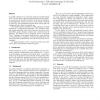1710 search results - page 102 / 342 » High-Level Programs and Program Conditions |
SPAA
2006
ACM
14 years 2 months ago
2006
ACM
Tree contraction algorithms, whose idea was first proposed by Miller and Reif, are important parallel algorithms to implement efficient parallel programs manipulating trees. Desp...
PEPM
2004
ACM
14 years 1 months ago
2004
ACM
Advanced typing, matching, and evaluation strategy features, as well as very general conditional rules, are routinely used in equational programming languages such as, for example...
ISCA
1999
IEEE
14 years 13 days ago
1999
IEEE
Several ILP limit studies indicate the presence of considerable ILP across dynamically far-apart instructions in program execution. This paper proposes a hardware mechanism, dynam...
MICRO
1993
IEEE
14 years 7 days ago
1993
IEEE
Compile-time code transformations which expose instruction-level parallelism (ILP) typically take into account the constraints imposed by all execution scenarios in the program. H...
PEPM
1992
ACM
14 years 6 days ago
1992
ACM
A partial evaluator is an automatic program transformation tool. Given as input a general program and part of its input, it can produce a specialized version. If the partial evalu...

